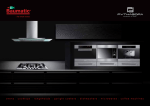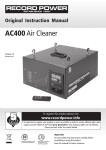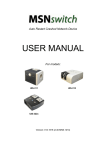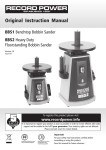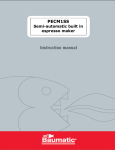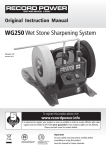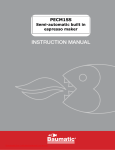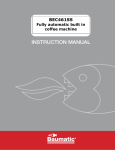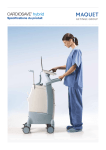Download Baumatic BAEC2SS.2 User manual
Transcript
User Manual for your Baumatic BAEC2SS.2 LIB30367 Semi-automatic built-in espresso maker NOTE: This User Instruction Manual contains important information, including safety & installation points, which will enable you to get the most out of your appliance. Please keep it in a safe place so that it is easily available for future reference; for you or any person not familiar with the operation of the appliance. DD 17/02/11 1 2 Contents Environmental note 4 IMPORTANT SAFETY INFORMATION 5–7 Specifications Product and aperture dimensions Product specifications Standard accessories Technical specifications Description of the coffee machine Control panel The filters 7 – 11 7 7-8 8 9 9 - 10 10 11 Things to do before first use Cleaning Filling the water reservoir (manual fill mode) What to do if the water level runs low during operation Getting started (Loading the system with water) 11 – 14 11 12 12 – 13 13 Using your espresso maker Dispensing hot water through the main boiler Dispensing steam through the steam boiler Dispensing boiler water through the steam boiler 14– 16 15 15 – 16 16 Making drinks Connecting the filter holder to the main boiler Making a drink using coffee pods Making drinks using espresso ground coffee Tips on making an espresso Tips on making a cappuccino Tips on making tea 17 – 21 17 17 – 18 18 – 19 19 – 20 20– 21 21 Cleaning and maintenance 23 – 24 Installation Electrical connection Installing the espresso maker into a kitchen cabinet 24 – 29 24 25 – 27 Troubleshooting 28 - 29 Coffee glossary Contact details 29 30 3 Environmental note o The packaging materials that Baumatic uses are environmentally friendly and can be recycled. o Please discard all packaging material with due regard for the environment. 4 IMPORTANT SAFETY INFORMATION Your safety is of the utmost importance to Baumatic. Please make sure that you read this instruction booklet before attempting to install or use the appliance. If you are unsure of any of the information contained in this booklet, please contact Think. General Information o This appliance is designed for domestic household use only. It can ONLY be built into a standard kitchen cabinet or housing unit and should NOT be used as a freestanding appliance. o The use of this appliance for any other purpose or in any other environment without the express agreement of Think will invalidate any warranty or liability claim. o Your new appliance is guaranteed against electrical or mechanical defects, subject to certain exclusions that are noted in Baumatic’s Conditions Of Guarantee. The foregoing does not affect your statutory rights. o Repairs may only be carried out by Baumatic service engineers or their authorised service agent. Warning and safety instructions • • This appliance is not intended for use by persons (including children) with reduced physical, sensory or mental capabilities, or lack of experience and knowledge, unless they have been given supervision or instruction concerning use of the appliance by a person responsible for their safety. Children should be supervised to ensure that they do not play with the appliance. o This appliance complies with all current safety legislation. Baumatic do wish to emphasise that this compliance does not remove the fact that the appliance surfaces will become extremely hot during use and retain heat after operation. o Extreme care MUST be taken when removing any of the filters or nozzles. They should be allowed to cool before they are removed from the appliance. 5 Child Safety o Baumatic strongly recommend that babies and young children are prevented from being near to the appliance and not allowed to touch the appliance at any time. o If it is necessary for younger family members to be in the kitchen, please ensure that they are kept under close supervision at all times. General Safety o Do not leave the espresso maker unattended. o Do not allow electrical fittings or cables to come into contact with areas on the appliance that get hot. o Do not install the appliance next to curtains or soft furnishings. Cleaning o Cleaning of the espresso maker should be carried out on a regular basis. o Great care should be taken whilst using this appliance and when following the cleaning procedure. o IMPORTANT: The appliance must be disconnected from the mains before following the cleaning procedure. Installation This appliance must be installed by a suitably qualified person, strictly in accordance with the manufacturer’s instructions. o Think declines any responsibility for injury or damage, to any person or property, as a result of improper use or installation of this appliance. 6 o The manufacturer declares that the espresso maker is built using certified materials and requires the appliance to be installed in accordance with the standards currently in force. This appliance must be used by a trained person for domestic purposes only. Specifications Product Dimensions Aperture Dimensions Height: Width: Depth: Height: Width: Depth: (min) 460 mm 596 mm 272 mm 450 mm 600 mm 560 mm Product specifications o o o o o o o o o Touch control operation Mark resistant coating Choice of 1 or 2 cup filters Suitable for sealed coffee pods or ground coffee Steam spout for cappuccino, hot chocolate, tea and instant coffee Pull-out drawer Compartment for cups & saucers Single pump with individual boilers for coffee making & cappuccino/steam Manual fill system 7 o Removable water tank (capacity 1.8 litres) o Empty water tank warning light o LED high density illumination Standard accessories o o o o o Filter holder 1 x one measure espresso cup filter 1 x two measure espresso cup filter 2 x espresso cups with saucers Water softener Technical specifications o o o o o o o Coffee pump pressure Total output Coffee boiler output Steam boiler output Power supply Supply connection Mains supply lead 15 bar 1860 W 1000 W 800 W 230 Vac 50 Hz 10 A plug to AS/NZS3112 3 x 1.5mm² For future reference please record the following information which can be found on the rating plate and the date of purchase which can be found on your sales invoice. The rating plate for your coffee machine can be located by opening the pull out drawer at the bottom of the coffee maker. Model Number ………………………………. Serial Number ………………………………. Date of Purchase ……………………………… 8 Description of the espresso maker Standard accessories 1) 2) 3) 4) 6) 9) 10) 11) Filter holder Spout for a single coffee dose Spout for a double coffee dose Filter for 1 Italian coffee pod or 1 dose of ground coffee Filter for 2 doses of espresso coffee or 1 French coffee pod Espresso coffee batcher (ground) Coffee pressing tool Water softener filter for the reservoir 12) 13) 14) 15) Drip tray Drip tray grid Water reservoir door Water reservoir 16) 17) 18) Pull out drawer Pipe for boiling water and steam Espresso cup stand 9 19) 20) 21) Filter holder ring nut Power ON/OFF switch Light Control panel 22) 23) 24) 25) 26) 27) 28) 29) 30) 31) 32) 33) Power ON indicator (green) Main boiler status indicator (green) Main boiler dispensing indicator (green) Steam boiler status indicator (green) Steam dispensing indicator (green) Boiling water dispensing indicator (green) Low water level indicator (red) Main boiler activation button Main boiler dispensing button Steam boiler activation button Steam boiler dispensing button Boiling water dispensing button 10 The filters o Filter for 1 Italian coffee pod or 1 dose of ground coffee. o Filter for 2 measures of espresso coffee of 1 French coffee pod. Things to do before first use 1) Cleaning o It is strongly recommended to clean the appliance prior to its first use. Particular attention should be paid to the water reservoir. o For further information on cleaning the appliance, please refer to the cleaning instructions on pages 23 - 25. 2) Filling the water reservoir (manual fill mode) 11 o Install the appliance as per the installation instructions contained within this booklet. o Open the water reservoir door (14) and remove the water reservoir (15) from the cabinet. o Remove the water softener filter (11) from its connecting pipe and immerse it in a bowl of cold water for approximately five minutes prior to reconnecting. o Fill the water reservoir with cold water until it is two thirds full. o Re-connect the water softener filter (11) to the longest tube and then place it inside the water reservoir, along with the other two tubes. o Put the water reservoir back into the cabinet. o IMPORTANT: Make sure that the water reservoir is positioned correctly on the pedal inside the water reservoir cabinet (as shown in the picture on the previous page). o Switch the appliance on using the power ON/OFF switch (20); the power ON indicator (22) will light. o If the water level in the water reservoir is not sufficient the low water level indicator (28) will start flashing. You should add more water to the water reservoir. o IMPORTANT: If the low water level indicator (28) remains steady even after filling the water reservoir with additional water, you should switch the machine off using the power ON/OFF switch (20) and then restart after few seconds. 2a) What to do if the water level runs low during operation o If whilst making drinks, the water reservoir runs low on water, the low water level indicator (28) will flash. The espresso machine will stop any drinks making operation that is in progress. o You should turn the appliance off using the power ON/OFF switch (20). o Then follow the process described above on filling the water reservoir manually. 12 o Restart the machine using the power ON/OFF switch (20). o You must start the drinks making process right from the beginning, as stated in the “Using your espresso maker” section (pages 15 – 17). 3) Getting started (Loading the system with water) IMPORTANT: YOU MUST FOLLOW THE STEPS BELOW BEFORE HEATING THE WATER BOILER FOR THE FIRST TIME. o Place a jug below the pipe (for boiling water and steam) (17). o Push the boiling water dispensing button (33). o Allow the appliance to have a constant flow of water running through the system for a few seconds. o Press the boiling water dispensing button (33) again to stop the flow of water from the pipe. Using your espresso maker IMPORTANT: Please note that the main boiler and the steam boiler CANNOT be operated at the same time. 1) Dispensing hot water through the main boiler o Follow the instructions on filling the water reservoir as stated previously and proceed as follows:o Press the main boiler activation button (29) to allow the boiler to heat up. During this process, the main boiler status indicator (23) will flash. o When the boiler has reached its operating temperature, the main boiler status indicator (23) will stop flashing and remain steady. o Place a cup underneath the filter holder ring nut (19) and then press the main boiler dispensing button (30). o To stop hot water from dispensing, press the same button again. 13 ¾ Noise generated during this operation is perfectly normal. This is caused by the activation of the high pressure pump during this operation. ¾ It is also quite normal for a certain amount of water to drip into the drip tray after water has been dispensed. 2) Dispensing steam through the steam boiler o Follow the instructions on filling the water reservoir (pages 12 – 13) as stated previously and proceed as follows:o Press the steam boiler activation button (31) to allow the boilers to heat up. During this process, the steam boiler status indicator (25) will flash. o Whilst the steam boiler is heating up, it is normal to get a small amount of water dripping from the pipe for boiling water and steam. (17). o When the boilers have reached their operating temperature, the steam boiler status indicator (25) will stop flashing and remain steady. o To dispense steam, press the steam boiler dispensing button (32). NOTE: Steam will dispense from the pipe for boiling water and steam (17). o To stop steam from dispensing, press the same button again. ¾ The noise generated during this operation is perfectly normal. This is caused by the activation of the high pressure pump during this operation. ¾ It is also quiet normal for a certain amount of water to drip into the drip tray after water has been dispensed. o WARNING: During this operation, extreme caution should be exercised, as the dispensing pipe will get hot. o When releasing steam, avoid directing the steam towards your person. There is a danger of scalding. o Always use a container or a mug underneath the dispensing pipe 14 whilst dispensing steam. 3) Dispensing boiling water through the steam boiler o Follow the instructions on filling the water reservoir (pages 11 – 14) as stated previously and proceed as follows:o Press the steam boiler activation button (31) to allow the boilers to heat up. During this process, the steam boiler status indicator (25) will flash. o Whilst the steam boiler is heating up, it is normal to get a small amount of water dripping from the pipe (17). o When the boilers have reached their operating temperature, the steam boiler status indicator (25) will stop flashing and remain steady. o To dispense boiling water, press the boiling water dispensing button (33). NOTE: Boiling water will dispense from the pipe (for boiling water and steam) (17). o To stop boiling water from dispensing, press the same button again. ¾ The noise generated during this operation is perfectly normal. This is caused by the activation of the high pressure pump during this operation. ¾ It is also quiet normal for a certain amount of water to drip into the drip tray after water has been dispensed. o WARNING: During this operation, extreme caution should be exercised, as the dispensing pipe will get hot. o When releasing boiling water, avoid directing boiling water towards your person. There is a danger of scalding. o Always use a container or a mug underneath the pipe whilst dispensing boiling water. 15 Making drinks Connecting the filter holder to the main boiler o Lift the filter holder (1) towards the filter holder ring nut (19); making sure that it is in the position shown in the drawing above. o Continue lifting the holder until it locates inside of the ring nut. o Turn the handle of the holder anti-clockwise, making sure that it is fully secured. o When you have finished using the holder, turn the handle clockwise and remove it from the filter holder ring nut (19). IMPORTANT: If the filter gets attached to the boiler, you should carefully remove it. This is a result of a vacuum being created during the espresso making process. Making a drink using coffee pods Coffee pods are an easy, practical and hygienic way to make coffee. The packaging used for coffee pods does not allow excess coffee to spill out and can be easily removed after use. o IMPORTANT: If you are using pods, then the filter for 1 Italian must be used. If you are using pods, then the filter for 1 French must be used. Italian coffee coffee pod (4) French coffee coffee pod (6) o For best results ensure that the coffee pods are used prior to their use by date. o Follow the instructions on filling the water reservoir (pages 11 – 14) and “Dispensing hot water through the main boiler” (page 15). 16 o To make a single dose of espresso, use the spout for a single coffee dose (2) and use one espresso cup. o To make a double dose of espresso, use the spout for a double coffee dose (3) and use two espresso cups. o Insert an appropriately sized coffee pod filter (4) or (6) into the filter holder (1). o Place the coffee pod into the filter holder (1) and place it onto the filter holder ring nut (19) on to the main boiler and lock it into position. o Place a suitably sized cup under the main boiler. If using the espresso for making espresso shots use the espresso cup stand (18). o Press the main boiler dispensing button (30). o When your espresso is made, press the same button again to stop hot water from dispensing. o Release the filter holder (1) from the filter holder ring nut (19). o When the coffee pod is sufficiently cooled, remove it from the filter holder (1) and discard it. o Wipe over the filters with a damp cloth, if you want to make another drink. o When you have finished making drinks, you can either wash the filters and spouts in hot soapy water or in a dishwasher. Making drinks using espresso ground coffee o Follow the instructions on filling the water reservoir (pages 11 – 14) and “Dispensing hot water through the main boiler” (page 15). o To make a single dose of espresso, use the spout for a single coffee dose (2) and use one espresso cup. o To make a double dose of espresso, use the spout for a double coffee dose (3) and use two espresso cups. o Insert the appropriately sized coffee pod filter (4) or (6) into the filter holder (1). 17 o Using the supplied espresso coffee batcher (ground) (9) put the required amount of espresso coffee into the filter holder (1). o Use the coffee pressing tool (10) to pack down the espresso coffee in the filter holder. Place the filter holder into the filter holder ring nut (19) on the main boiler and lock it in position. o IMPORTANT: Do not overfill or compact the espresso coffee too tightly. Doing this will not allow the water to flow freely. o Place a suitably sized cup under the main boiler. Use the espresso cup stand (18) if using the espresso cup. o Press the main boiler dispensing button (30). o When your espresso is made, press the same button again to stop hot water from dispensing. o Release the filter holder (1) from the filter holder ring nut (19) and discard the used espresso coffee. o Wipe over the filters with a damp cloth, if you want to make another drink. o When you have finished making drinks, you can either wash the filters and spouts in hot soapy water or in a dishwasher. Tips on making an espresso An espresso is a strong black coffee that is made by forcing pressurised hot water, through finely ground espresso coffee. o Approximately 7 grams of coffee is required for an espresso. After filling the filter with coffee, use the coffee pressing tool (10) to tap down the coffee in the filter holder. Remove any excess coffee from the filter holder before making the espresso. o If you are using the small cups especially designed for espressos, then you should utilise the espresso cup stand (18) to raise the cup closer to the filter holder (1). o The main boiler should be pre-heated and a small amount of water should be dispensed through the machine to warm it up. 18 o The espresso cups should also be warmed before making any espresso drink. Tips on making a cappuccino An espresso topped with an equal amount of steamed milk and froth. o IMPORTANT: When making a cappuccino, the steam boiler should be heated before the main boiler in order to reduce the time taken to heat up the main boiler. o After making a cup of espresso, you should follow the dispensing steam from the steam boiler section (pages 15 – 16). o Press the steam boiler dispensing button (32) and release steam for a few seconds onto the drip tray. During this time, a certain amount of condensed water will be released. o Press the steam boiler dispensing button again to stop the steam dispensing. o IMPORTANT: Using the metal jug supplied along with the appliance, fill approximately 150 - 200 ml of milk required for frothing. o Press the steam boiler dispensing button for the third time and allow the steam to flow onto the drip tray for few seconds. Once a steady flow of steam is obtained, immerse the pipe (for boiling water and steam) (17) into the milk, holding the rubber sleeved section. o Move the container of milk up and down very slowly whilst simultaneously rotating the container at the same time. o The temperature of the milk should be monitored by carefully touching the container with the palm of your hand. o Milk should not be overheated, in order to avoid it being diluted. o When the required froth has been achieved, press the steam boiler dispensing button to stop the function. 19 o Put the espresso shot into a large cup and then pour the heated milk from the jug into it. The froth achieved during the frothing process should be spooned over the top. o IMPORTANT: To get the best results, milk should be semi-skimmed and preferably at room temperature. o After using the above function, a certain amount of steam should be dispensed through the pipe several times and the froth making nozzle cleaned with a damp cloth. o The froth making nozzle can be dismantled and washed in a dishwasher. o NOTE: You can also use the steam pipe to heat up other beverages such as water, punch and hot chocolate etc. Tips on making tea o For loose leaf tea, follow the instructions as stated in the “Making drinks using espresso ground coffee” section (page 19 - 20). o For tea bags, follow the instructions as stated in the dispensing boiling water through the steam boiler section (pages 15 – 16). 20 Cleaning and maintenance Cleaning operations must only be carried out when the coffee maker is cold. The appliance should be disconnected from your mains supply before commencing any cleaning process. Stainless steel sections o The stainless steel sections should be cleaned using warm soapy water. o No abrasive detergents or cleaners should be used. o No abrasive sponges or steel wool should be used on any area of the appliance. o Dry the appliance afterwards thoroughly with a soft cloth. o We would recommend that an appropriate stainless steel cleaner and polish is regularly used on the stainless steel surfaces. Steam pipe o You should flush the steam pipe thoroughly with steam after each use. o NOTE: When milk cools, it creates impurities which may block the steam discharge hole and cause the appliance to function poorly. o If you have used the steam pipe, you should dismantle the froth making device and wipe both the sections using a clean sponge or a damp cloth. Water reservoir o If you are not using the appliance for a long period of time, you should drain the boiler by following the “Dispensing hot water through the main boiler” section (page 15). o Press the main boiler dispensing button (30) until the reservoir is empty. o If your appliance is connected to your mains water supply, you should turn the machine off using the power ON/OFF switch or from the mains, before it starts to refill the reservoir. 21 o Clean the water reservoir regularly using warm soapy water and make sure that the water reservoir has been rinsed thoroughly before being placed back in the machine. The drip tray o Pull the storage drawer forward and remove the drip tray. o You can either wash this drip tray in warm soapy water or wash it in a dishwasher. o Make sure that the drip tray and cover are thoroughly dried before reinstalling. Water boiler o Depending on the water hardness in your area of the country, it is normal for limescale to form in the boilers. Therefore it is recommended that you should carry out the following process at least every six months. o Manually fill the water reservoir with 2 litres of water. o Add half a glass of citric acid or vinegar to the water reservoir. o Follow the process stated in the “Dispensing hot water through the main boiler” section (page 15) and follow the process stated in the “Dispensing boiling water through the steam boiler” section (pages 15 – 16). o When the water reservoir is completely empty, fill the reservoir with cold water (either manually or automatically) and then dispense water until the reservoir is empty again. o You should do this twice to make sure that there are no traces of citric acid or vinegar left in the water reservoir. o IMPORTANT: There are coffee boiler cleaners that are readily available from supermarkets or D.I.Y. stores. Please refer to the manufacturer’s instructions when using these products. Water softener o The water softener will need to be replaced approximately every six months. o If the colours of the granules in the water softener have changed from their original colour, then it is time to replace it. 22 o A replacement water softener can be obtained from the Baumatic Spares Department. o When a new water softener is fitted, you should follow the filling the water reservoir instructions. INSTALLATION Installation of this appliance must be carried out by a suitably qualified person, in accordance with the current version of the following. o UK Regulations and Safety Standards or their European Norm Replacements. o Building Regulations (issued by the Department of the Environment). o Building Standards (issued by the Scottish Development Department). o IEE Wiring Regulations. o Electricity At Work Regulations. Before connecting the appliance, make sure that the supply voltage marked on the rating plate corresponds with your mains supply voltage. WARNING: THIS APPLIANCE MUST BE EARTHED. o This appliance should be plugged into a 10 A General Purpose Outlet (GPO), placed in an easily accessible position adjacent to the appliance. The GPO must still be accessible even when your coffee machine is located in its housing. o If you have to change the coffee machine power cord, the earthing (yellow/green) conductor must always be 10 mm longer than the line conductors. o Care must be taken to ensure that the temperature of the mains supply cable does not exceed 50°C. o If the mains supply cable is damaged, then it must be replaced with a suitable cable. 23 Installing the espresso maker into a kitchen cabinet o Ensure that the aperture that you will be fitting the coffee machine into is of the size given in the diagram above. o Ensure that the rear panel of the furniture housing unit has been removed and that the ventilation cut out shown is adhered to. 24 o You must ensure that there is a hole to feed the electrical cable through. These steps must be done before commencing the rest of the installation process. 1. Measure a height of 200 mm from the base of the housing unit. Then at that height, measure out a distance of 225 mm from the front of it and mark it. You should make the same measurement and marking on both sides of the housing unit. 2. On the marks that you have just made, use the screws provided to fix a support piece to either side of the housing unit. 3. Use a spirit level to make sure that the support pieces are vertically level. You should also feed the electrical cable through the hole that you have made for it in the housing unit. You should NOT connect the cable to the GPO at this stage. 4. Place the coffee machine inside of the housing unit. 25 5. Sit the coffee machine in the housing unit. You must make sure that the coffee machine is flush with the housing unit, otherwise it will not line up properly with the support pieces. 6. There are two screw holes on the main body of the coffee maker, one on the right hand side of the machine and the other on the left hand side. You have to open the water reservoir door (14) and remove the water reservoir (15) to access the left hand one. 7. Fix the coffee machine against the housing unit by fully tightening the screws provided, through the screw holes on the above drawing. 8. Follow the electrical connection information on page 24 and then check that the appliance is functioning correctly. IMPORTANT: You must follow the before first use section on pages 11 - 14. 26 TROUBLESHOOTING My espresso machine will not work at all. o Check your mains supply and the electrical connection. My espresso machine will not dispense water. Check that the water reservoir is filled with water and the water softener and other tubes are immersed in the water reservoir. Is it ‘OK’ to leave my espresso machine switched ON? o Appliance should not be left unattended when drinks making process is in progress. o The appliance will go in a stand by mode when not in use after approximately 60 minutes. To restart follow the drink making processes from the start. Flashing red light o Low water level in the water reservoir. Follow the filling instructions. Steady red light o Low water level in the water reservoir. Follow the filling instructions. All ‘LED’ light indicators flashing constantly o Switch off the appliance and restart after approximately 60 minutes. If the error still persists, contact the Customer Care Department to arrange an engineer’s visit. 27 Coffee glossary Caffe- Italian word for a standard espresso Caffe Americano- a thin espresso with water added Caffe latte- a double espresso mixed in a large cup with hot milk. It should be topped with little or no foam. Caffe mocha- made from equal parts milk and cocoa. Caffeine- espresso’s caffeine content is only a third or half of that found in coffee. The stronger the roast, the less caffeine the espresso will contain. Cappuccino- is espresso frothed with milk. It is equal parts of espresso, foam and hot milk. Crema- this is the sign of the perfect cup of espresso; a fine, nutty or cinnamon brown foam on the surface of the espresso. This is only created when the pressure is sufficiently high. The crema contains the foamed oils which are rich in flavour and aroma. Espresso- see “caffe”. Macchiato- espresso carrying a dollop of hot, foaming milk to give a dappled look. IMPORTANT: If your appliance appears not to be operating correctly, then you should disconnect it from your mains supply and then contact the Customer Care Department on telephone number 1 800 444 357 DO NOT ATTEMPT TO REPAIR THE APPLIANCE YOURSELF. The manufacturer has the right to change any specifications on the product without giving prior notice. Please note that if an engineer is asked to attend whilst the product is under guarantee and finds that the problem is not the result of an 28 appliance fault, then you may be liable for the cost of the call out charge. The appliance must be accessible for the engineer to perform any necessary repair. If your appliance is installed in such a way that an engineer is concerned that damage will be caused to the appliance or your kitchen, then he will not complete a repair. This includes situations where appliances have been tiled in, sealed in with sealant, have wooden obstructions placed in front of the appliance, like plinths. Or any installation other than the one specified has been completed. Please refer to the conditions of guarantee that appear on the warranty card that you receive with the appliance. IMPORTANT: The manufacturer operates a policy of continuous improvement and reserves the right to adjust and modify its products without prior notification. 29





























